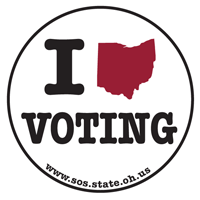
Voter Registration in Ohio
By Michael Curtin
Ohio has 9.3 million eligible voters, of whom 7.7 million are registered to vote in the Nov. 8, 2016 election.
Secretary of State Jon Husted has mailed notices to the 1.6 million eligible but unregistered Ohioans that they have until Oct. 11 to register for this year’s hotly-contested presidential election.
With so much attention given voter registration today, it might surprise many Ohioans to learn that, prior to 1978, our state did not have a statewide registration requirement.
From adoption of Ohio’s first voter registration law in 1885, it took 93 years for the state to adopt legislation that applied the same standard across all 88 counties.
Three decades into statehood, Ohio lawmakers began debating the need for a voter registration law. However, in 1837, the House Judiciary Committee recommended against it because it would be “impracticable in a new and rapidly settling country” where the population was constantly changing, wrote David M. Gold, author of Democracy in Session: A History of the Ohio General Assembly.
Without registration requirements, voters simply showed up at their neighborhood polling place, signed and addressed poll books, and showed a piece of identification when requested.
Like many states, Ohio grew more serious about voter registration after the Civil War, as large numbers of citizens moved from farms to cities.
On May 4, 1885, the legislature passed a law requiring registration of voters in Ohio’s two largest cities – Cincinnati and Cleveland.
The law required the two cities to create wards containing no more than 300 voters in each, and to appoint “voter registers” – one from each major party in each precinct – to supervise registration. Those registering were required to list name, address, age and marital status.
However, eight months later, the Ohio Supreme Court declared the law unconstitutional because it provided only seven days for registration.
The court ruled the General Assembly has the power to adopt a registration law, but not one so restrictive.
“There is no provision for registering at pleasure during the earlier part of the year, and no provision for providing his qualifications on election day and voting,” the court reasoned. “How many mechanics may be absent pursuing their trades during the seven days!”
The court laid down a balancing test that Ohio has struggled to meet ever since: “We believe it is an easy task to frame a registry law that, while protecting the election from fraudulent votes, and securing the integrity of the ballot, will in no practical way impede or injuriously restrain the constitutional right of the voter,” the court instructed.
The next year, the legislature passed a law giving control of elections in Ohio’s major cities to boards of elections.
The General Assembly also began to set population thresholds at which cities would be required to register voters, allowing local boards of elections to determine the length of registration periods.
For much of the 20th century, voter registration was not required until a municipality reached a population of 16,000.
In larger population counties, municipal boards of elections gradually were consolidated into county boards of elections.
However, as recently as 1952, only 17 of Ohio’s 88 counties were “full registration” counties, and an additional 18 were “partial registration” counties. That left 53 counties without any registration requirement.
By 1972, 53 counties had adopted countywide registration, seven had partial registration, and 28 still had no registration requirements.
Perhaps the biggest voter registration fight in Ohio history occurred in 1977. In control of both houses of the General Assembly, Democrats overrode a veto by Republican Gov. James A. Rhodes and enacted legislation establishing election-day and permanent registration statewide. The law removed a 30-day precinct and county residency requirement.
At the time, boards of elections in registration counties removed people from the voting rolls if they failed to vote in any election for two successive years.
Such voters would be mailed postcards informing them of the need to re-register – in person.
Republicans wasted no time in challenging the law. The GOP led an initiative petition campaign, gathering 365,985 valid signatures to place what became State Issue 1 on the Nov. 8, 1977 ballot.
Approved by a 62-38 ratio, the amendment repealed election-day and permanent registration, established a 30-day, statewide registration requirement effective in 1978, and required re-registration if a voter failed to vote at least once in a four-year period.
For the first time, Ohio had a standard statewide voter registration requirement, effective for the Nov. 7, 1978 election.
As of Jan. 1, 1979, the Ohio secretary of state was required to maintain a master list of registered voters, compiled from the 88 county boards of elections. The state also began allowing registration by mail.
Earlier this year, the General Assembly approved a bill to provide for online voter registration and re-registration. However, the law does not take effect until next year.
The march of technology almost certainly ensures an ongoing debate over how best to balance an unrestrained right to vote with ballot integrity.
Curtis B. Gans, the co-founder and longtime director of the Center for the Study of the American Electorate, who died last year, in 2009 urged Congress to consider the merits of government-issued, biometric ID cards for everyone 18 and over.
Such cards, Gans reasoned, not only would eliminate the need for state-by-state voter registration, but could ensure a fully accurate federal census, and provide secure ID for medical records, Social Security, Medicare, driver’s licenses and more.
Columbus native Michael F. Curtin is currently a Democratic Representative (first elected 2012) from the 17th Ohio House District (west and south sides of Columbus). He had a 38-year journalism career with the Columbus Dispatch, most devoted to coverage of local and state government and politics. Mr. Curtin is author of The Ohio Politics Almanac, first and second editions (KSU Press). Finally, he is a licensed umpire, Ohio High School Athletic Association (baseball and fastpitch softball).
